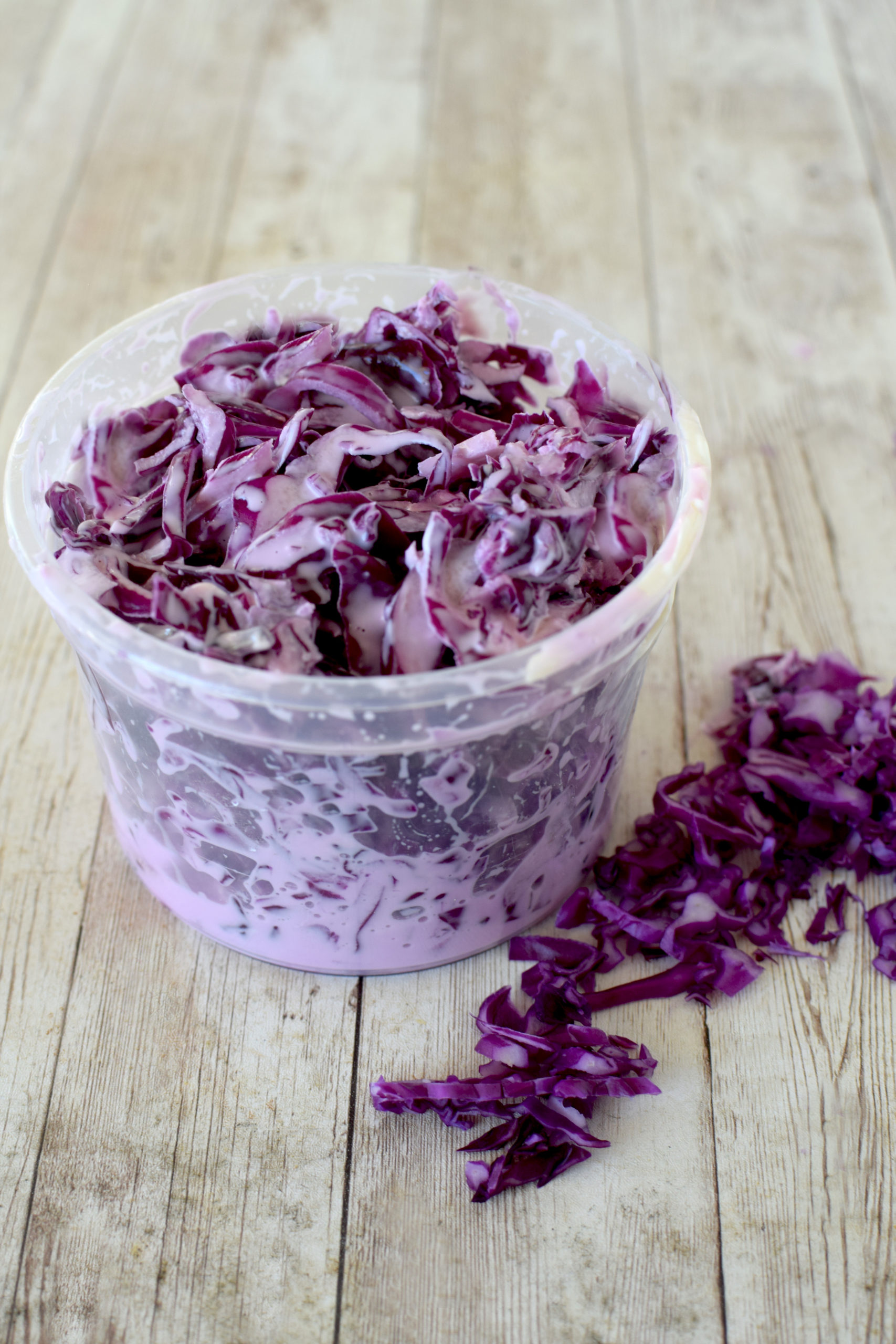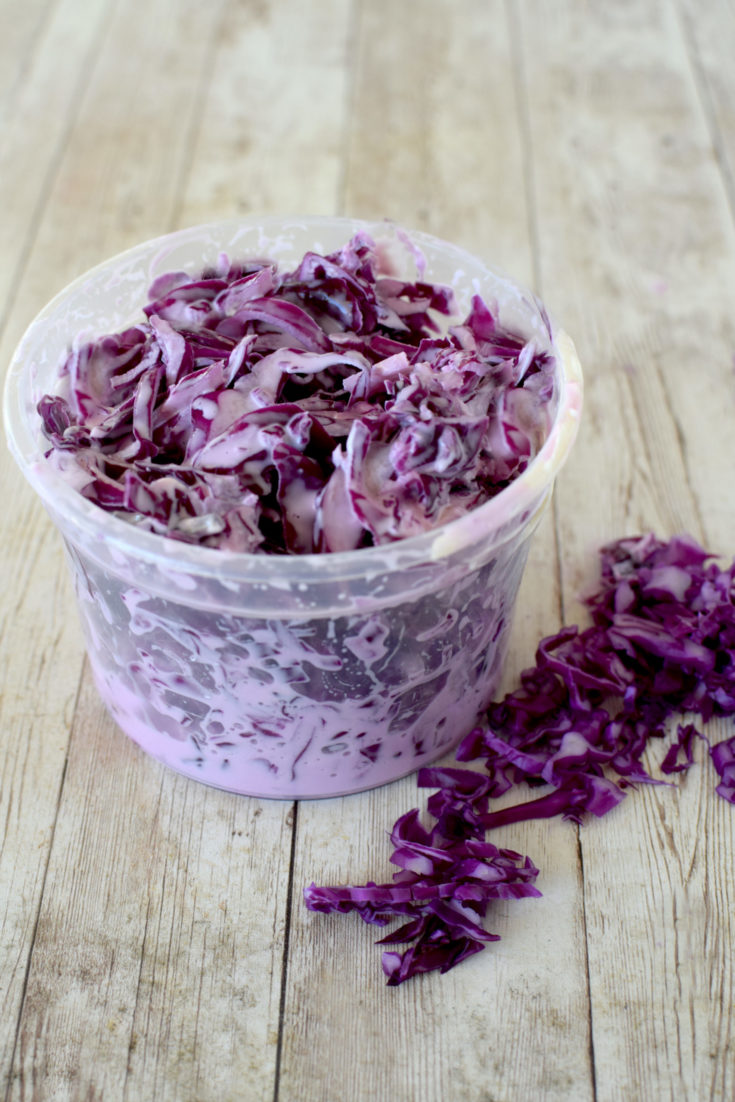Red Cabbage Salad for Passover is a simple, 3-ingredient sweet deli salad made with mayonnaise. Vegetarian and delicious!

Red Cabbage Salad for Passover is a great side dish to add to any meal during the week of Passover. And since there is no matzo in the ingredients, it’s perfect even for the day of the seder!
Eating on the day of the seder
Jews who keep the laws of Passover do not eat matzo or any foods that contain anything from matzo (such as matzo meal or matzo cake meal) the entire day before the seder, which is in the evening.
Some people even have the custom of not eating such foods for two weeks before, beginning on Rosh Chodesh Nissan or even as far back as Purim, which is a month before.
Food on Passover
Torah-observant Jews do not eat chametz (the fermented products of five grains: wheat, spelt, barley, oats, and rye).
In addition, Torah-observant Ashkenazi Jews do not eat kitniyot (or kitniyos as pronounced in Ashkenazi Hebrew). These include legumes, corn, rice, and similar foods that were deemed forbidden to eat by rabbis in the medieval period and are still not eaten today. Sephardi and Mizrachi Jews do not follow this tradition.
Many observant Ashkenazi Jews will not even eat the derivatives of these kitniyot, while others do (each family holds their own traditions regarding this).
Then, there are Ashkenazim who don’t eat “gebrokts” (or gebrochts).
Gebrokts (gebrochts) means “broken” in Yiddish, and in this case refers to matzo that has absorbed liquid. Not eating gebrokts is observed by many in the Hasidic Jewish community and Ashkenazim who have taken on this tradition, where they basically don’t mix anything wet with matzo.
So, things like matzo sandwiches, fried matzo, and even matzo balls are a no-no for them.
There is a joke that sums it all up:
On Passover, we should remember people who have little to eat on this holiday. They are called Ashkenazim.
Over the years, I have learned to adapt “normal” food for Passover so that my family won’t complain about boring, tasteless, or repetitive meals.
I find that having good food and variety makes the week of Passover a very pleasant experience, and I hope this recipe will help make yours just that!
A little of my cooking background
I really wanted to title this blog “If I can make it, anyone can” because, honestly, if I can make it, anyone can.
I never really liked cooking, and when I was single, a meal for me meant grilled cheese, eggs, tuna, or something else that didn’t require effort or time.
When my kids were young, I was still able to get away with preparing only a small variety of easy meals, but the older they got, the more dishes I learned to make at their request.
Still, I insisted on keeping it simple.
Honestly, I never understood why some cooks unnecessarily complicate meals. I have seen recipes that have several ingredients that don’t really seem to add much, if anything, to the dish. So, why bother?
It has always been important to me that whoever eats at my table will have plenty to enjoy, and that includes my kids (I never agreed with the “You will eat what is served, or you won’t eat” ideology), and, because I keep it simple, I can prepare a variety of dishes in a relatively short period of time.
I have a philosophy regarding being a great cook: Prepare food according to the tastes of those who will be eating it, and they will love your cooking!
As far as I am concerned, start with the basic ingredients that make the dish what it is, adapt according to taste, and voila! You are an amazing cook!
The bottom line is that while there are certainly delicate recipes out there for specialty dishes, making delicious meals doesn’t have to be complicated or time-consuming. It’s not difficult to impress—just make sure it tastes good.
While some of the recipes on my blog are more time-consuming than others, they are all tried and true, easy-shmeezy!
Of course, one always has to consider the conditions under which they cook. Weather (humidity, heat, cold), different types of ovens, different qualities of pots, etc.—all of which can affect your cooking and baking.
Nevertheless, as I said, if I can do it, anyone can!
A little about red cabbage
While this vegetable is called “red” it is is mostly found in more of a purple color. It will change its color according to the PH value of the soil it grows in; in acidic soil, it will be more reddish and in more neutral soil, it will be more purple.
It is believed that red cabbage was first brought to Europe by the Celtics and was spread throughout Europe by the Romans. At first it was mainly used by peasants for themselves and their livestock and only began to appear in the food of the wealthy sometime in the 1700s.
Red cabbage has a high content of both vitamin C and vitamin K.
Just saying…
While some people have a talent for cooking, for some it can take a while of practice, trial, and error.
Everything I cook or bake is easy (or, as some would say, “stupid simple”), and most of my recipes have minimal ingredients and take minimal effort.
Many foods have a variety of recipes, based on tradition, location, family, or taste. While some ingredients are non-negotiable in a recipe, most can be tailored, so feel free to adjust the sugar and mayonnaise to suit your own taste (just remember that as the sugar melts and combines with the cabbage juices, it will taste sweeter than when you first add the sugar).
While I dislike making complicated recipes, Passover brings with it its own set of challenges. I can’t even tell you how many times I have seen posts that ask for new ideas because someone’s family is tired of the same old food.
Red Cabbage Salad for Passover

Easy Israeli style sweet red cabbage salad with mayonnaise for Passover
Ingredients
- 4 cups shredded red cabbage
- 3 tablespoons kosher for Passover mayonnaise (or more if desired)
- 1 tablespoons white granulated sugar (or to taste)*
Instructions
- Mix all ingredients together in a large mixing bowl.
- Refrigerate for 1/2-1 one hour to let the sugars release.
Notes
*While sitting, the juices from the cabbage and carrots will combine with the sugar and create a sweet dressing and will taste sweeter than when originally mixed, so don't overdo the sugar.
Nutrition Information:
Yield:
6Serving Size:
1Amount Per Serving: Calories: 53Total Fat: 2gSaturated Fat: 0gTrans Fat: 0gUnsaturated Fat: 1gCholesterol: 1mgSodium: 43mgCarbohydrates: 9gFiber: 3gSugar: 5gProtein: 2g